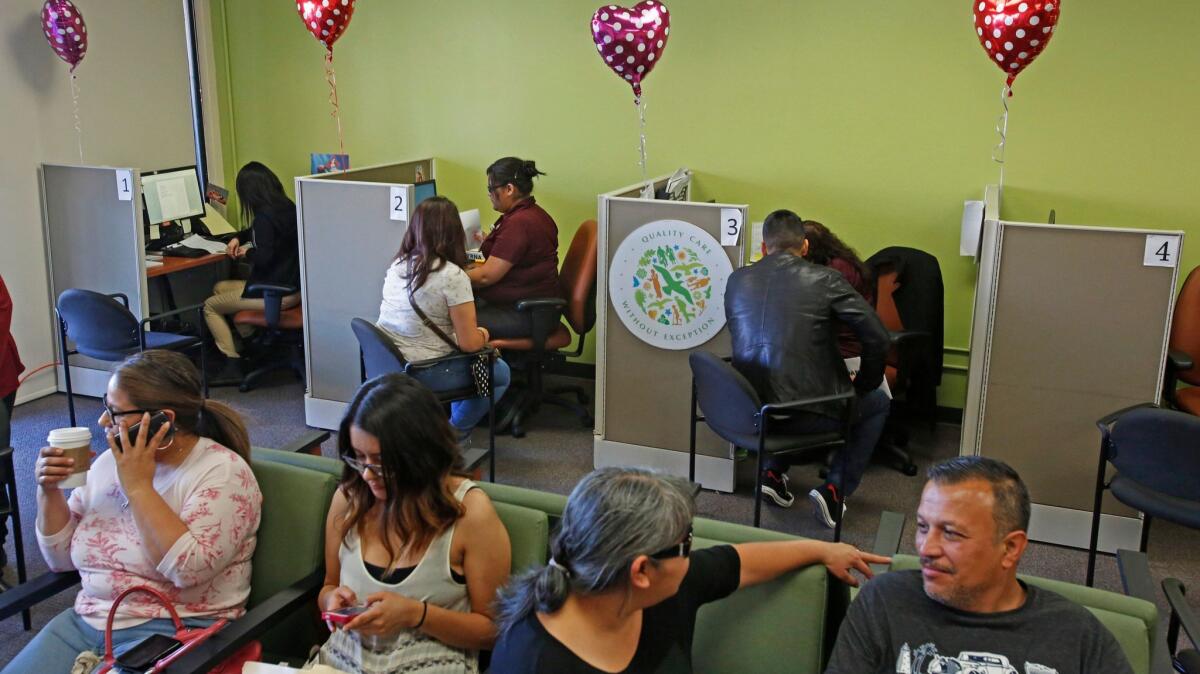Turmoil in Washington adds uncertainty to health insurance enrollment

Usually, the autumn ritual of selecting the right health plan for the coming year is quite predictable. The options are there on the table, and there is usually little thought that things might change dramatically after you make a decision.
Not this year.
President Trump tweeted this summer that he might end cost-sharing subsidies to health insurance companies if Congress can’t get together on long-promised plans to repeal and replace the Affordable Care Act, or Obamacare. So open enrollment in California this season — which begins Nov. 1 and runs through Jan. 31 — comes with an unprecedented edge of unease.
Dave Jones, California’s health insurance commissioner, does not attempt to sugarcoat the effect that so much heated rhetoric has had on the task of getting insurance companies to offer affordable rates to consumers, especially in the private health insurance market now dominated by the Covered California health insurance exchange.
“This has been the most unstable and challenged health insurance market in my tenure as a public servant,” Jones said. “The degree of uncertainty and instability that the Trump administration has injected into the market this year cannot be understated.”
That turmoil has most directly affected the 1.4 million Californians who buy exchange plans and about 1 million more estimated to purchase individual coverage plans off-exchange.
It is this group, plus 3.8 million California adults enrolled in Medi-Cal since it was expanded in 2014, whose coverage has been the subject of political debate for several years.
While attempts to repeal and replace the Affordable Care Act have failed, there are still several steps the president could take to undermine the controversial program.
Already the new administration has said it would not enforce the penalties assessed for those who don’t buy health insurance. And Trump’s decision to target out-of-pocket cost-reducing payments to insurance companies also introduced a fair bit of volatility.
There has also been talk that the federal government will not support outreach efforts to some types of potential policyholders, especially those in Latino communities. Enrollment there is often seen as critical to bringing in enough healthy people to offset the costs incurred by older and sicker Americans who are much more likely to sign up for coverage.
On Aug. 1, Peter Lee, Covered California’s director, said the average increase for exchange plan premiums in 2018 will be 12.5%. He attributed about 3% of that bump to insurance company uncertainty about whether or not the new administration will undermine existing Affordable Care Act programs.
In some cases, Lee said, policyholders will be able to limit their premium hikes to less than 4% by moving into a different plan within their home market. In Los Angeles, seven carriers are offering plans. Premium increases in the region range from 10% in Orange County to 13% in Los Angeles.
Of course, the individual healthcare market is only a small fraction — about 9% in California — of the overall health insurance pie. The largest segment, representing 45% of all Californians in 2015, according to the Kaiser Family Foundation, get their coverage from an employer. Those plans generally hold enrollment in the fall.
An additional 38% is enrolled in a government program such as Medicare and Medi-Cal.
It’s a little harder to peg just how much premiums for employer-sponsored plans will increase in 2018.
Every year the National Business Group on Health surveys large employers nationwide to get a sense of how much costs will increase in the coming year. This time around, the nonprofit announced that costs were up about 5%, a number that should roughly translate to the premium increase that employees of large companies will see in 2018, according to Brian Marcotte, the business group’s president and chief executive.
A separate survey by the Kaiser Family Foundation and the Health Research & Educational Trust found that premiums for employer plans rose 3% this year, to an average $18,764. That cost is usually divided between employers and workers.
Marcotte said employers are continuing strategies that have gradually come to the fore over the last few years to contain healthcare costs as much as possible. Most companies, he said, are building in income-based premiums for employees. Gone are the days when the premium list was the same for everyone on the payroll.
“That means if you make more, you end up paying a higher monthly premium,” Marcotte said.
And there has also been a big increase in the number of employers offering “self-directed health plans” that combine high deductibles with special health savings accounts that the employer funds to help defray costs. The average contribution, Marcotte said, is $650 per year for an individual and $1,000 per family. Average deductibles for these plans, he added, are $1,500 per individual and $3,250 per year for family coverage.
“Today we have 90% of large employers offering self-directed plans with attached health savings accounts and 40% are offering these as their only option in 2018,” Marcotte said.
Sisson writes for the San Diego Union-Tribune.
More to Read
Inside the business of entertainment
The Wide Shot brings you news, analysis and insights on everything from streaming wars to production — and what it all means for the future.
You may occasionally receive promotional content from the Los Angeles Times.










